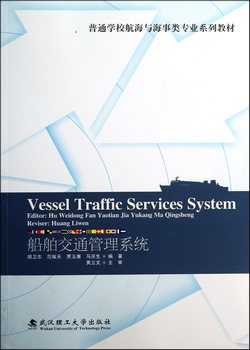- 武汉理工大学出版社
- 9787562938408
- 49750
- 52171152-3
- 2013-01
- U697
- 航海与海事类
- 本科
内容简介
《船舶交通管理系统》由VTS业务篇、VTS规划决策篇、VTS设备篇三部分组成。VTS业务篇包含绪论、规划VTS、构建VTS、AIS、VTS人员、运行VTS等六章;VTS规划决策篇包括风险决策方法简介、风险的分类及风险分析等三章;VTS设备篇包括VTS的基本组成、雷达子系统、VHF通信子系统、信息传输子系统、雷达数据处理子系统、新技术在VTS中的应用等六章。全书共计十五章。
《船舶交通管理系统》面向海事管理专业本科生,是教育部海事管理专业卓越工程师培养计划系列教材之一,也可作为航海技术专业本科生、交通信息工程及控制专业研究生参考教材、VTS操作员、VTS维修工程师自学参考用书。本书由胡卫东、范耀天、贾玉康、马庆生编著。
《船舶交通管理系统》面向海事管理专业本科生,是教育部海事管理专业卓越工程师培养计划系列教材之一,也可作为航海技术专业本科生、交通信息工程及控制专业研究生参考教材、VTS操作员、VTS维修工程师自学参考用书。本书由胡卫东、范耀天、贾玉康、马庆生编著。
目录
PART Ⅰ VTS Services
1 Introduction
2 Planning a VTS
2.1 FACTORS TO BE TAKEN INTO ACCOUNT WHEN CONSIDERING VTS
2.1.1 General
2.1.2 Development and Procurement
2.1.3 Inception Phase
2.1.4 Feasibility and Design Study Phase
2.1.5 Risk Assessment Phase
2.1.6 Cost/Benefit Phase
2.1.7 Implementation Phase
2.1.8 Evaluation Phase
2.2 SERVICE AND OPERATING OPTIONS
2.2.1 Service Options
2.2.2 Information Service
2.2.3 Navigational Assistance Service
2.2.4 Traffic Organisation Service
2.2.5 Operating Rules and Regulations
2.2.6 Co-operation with Allied Services,Port Operations,Emergency Services and adjacent VTS
2.3 TECHNICAL OPTIONS
2.3.1 Data Collection
2.3.2 Data Evaluation
2.3.3 Data Dissemination
2.4 LEGAL CONSIDERATIONS
2.4.1 General
2.4.2 Authority
2.4.3 Relationship between VTS and Vessels
2.4.4 Liability
2.5 VTS IN INLAND WATERS
3 Structuring a VTS
3.1 OPERATING PRINCIPLES & METHODS
3.1.1 Principles
3.1.2 Methods
3.2 PROVISION OF FACILITIES
3.2.1 Infrastructure to Support a VTS
3.2.2 Operational Aspects of the Infrastructure
3.2.3 Technical Aspects of the Infrastructure
3.2.4 Administrative Aspects of the Infrastructure
3.3 PROVISION OF EQUIPMENT
3.3.1 General
3.3.2 Division of a VTS Area into Sub-areas or Sectors
3.3.3 Surveillance Requirements for the VTS Area
3.3.4 Communication Requirements
3.3.5 Additional Equipment
3.3.6 Availability and Reliability of Equipment
3.3.7 Selection of Equipment
3.3.8 Documentation
4 AIS-A VTS Tool
4.1 GENERAL
4.2 BENEFITS OF AIS
4.2.1 Automatic Vessel Identification
4.2.2 VHF Communications
4.2.3 Improved Vessel Tracking
4.3 INSTALLATION OF AIS INTO A VTS-ISSUES TO BE CONSIDERED
4.3.1 Number/Location of Base Stations/Repeaters
4.3.2 Operability with Adjacent VTS Organizations
4.3.3 Availability of Suitable VHF Communications Channels
4.3.4 Availability of national/regional/local DGNSS corrections
4.4 OTHER ISSUES TO BE TAKEN INTO CONSIDERATION
4.4.1 Integration of AIS into Existing Radar-based Systems
4.4.2 Use of Electronic Charts
4.4.3 Choice of VTS Symbols
4.5 AIS AND AIDS TO NAVIGATION
4.6 AIS FOR METEOROLOGICAL AND HYDROLOGICAL INFORMATION
4.7 SHORT TERM ACTION BY VTS AUTHORITIES
5 VTS Personnel
5.1 INTRODUCTION
5.2 RECOMMENDATION V-103 ON STANDARDS FOR TRAINING AND CERTIFICATION OF VTS PERSONNEL
5.2.1 Job Descriptions
5.2.2 Selection and Recruiting
5.2.3 Training
5.2.4 Competence Charts
5.3 MODEL COURSES
5.3.1 General
5.3.2 Basic and Advancement Training
5.3.3 On-the-Job Training
5.4 ACCREDITATION OF TRAINING INSTITUTES
5.5 CERTIFICATION OF EXISTING VTS PERSONNEL
5.6 STAFFING LEVEL
5.6.1 The Comparison of Outcomes against the VTS Service Level Agreement
5.6.2 The Optimum Time that a VTS Operator/Supervisor Should Spend at a Workstation
5.6.3 The extent of Machine Assistance Available to the Operator/Supervisor
5.6.4 Communication Requirements
5.6.5 The Ability of the Staff on Duty to Deal with Emergencies and Unplanned Events
5.6.6 The Risks of Poor Performance Associated with Workload Stress
6 Operating a VTS
6.2 ADMINISTRATION AND SUPPORT
6.2.1 Introduction
6.2.2 Administration
6.2.3 Support Activity
6.3 QUALITY CONTROL
6.3.1 General
6.3.2 Practices and Procedures
6.4 EXTERNAL RELATIONS
6.4.1 General
6.4.2 Provision of Information
6.4.3 Public Relations Programme
6.5 CO-OPERATION WITH ALLIED SERVICES AND EMERGENCY SERVICES
6.5.1 Pilotage
6.5.2 Emergency Services
PART Ⅱ APPLICATION OF RISK-BASED DECISION MAKING ON PLANNING VTS
Introduction
1 Risk-based Decision-making in Planning for a VTS
1.1 SAFETY AND RISK
1.2 TRADITIONAL APPROACH TO MAKING DECISIONS CONCERNING MARI-TIME SAFETY
1.3 RISK-BASED DECISION-MAKING(RBDM)
1.4 VESSEL TRAFFIC SERVICE(VTS)
1.5 FORMAL SAFETY ASSESSMENT(FSA)
2 Identification of Risks and Hazards
2.1 DEFINE PROBLEM
2.1.1 VTS vessels
2.1.2 Types of VTS
2.1.3 Traffic rules and regulations
2.1.4 Risk to Be Considered
2.1.5 Geographical Boundaries
2.1.6 D
1 Introduction
2 Planning a VTS
2.1 FACTORS TO BE TAKEN INTO ACCOUNT WHEN CONSIDERING VTS
2.1.1 General
2.1.2 Development and Procurement
2.1.3 Inception Phase
2.1.4 Feasibility and Design Study Phase
2.1.5 Risk Assessment Phase
2.1.6 Cost/Benefit Phase
2.1.7 Implementation Phase
2.1.8 Evaluation Phase
2.2 SERVICE AND OPERATING OPTIONS
2.2.1 Service Options
2.2.2 Information Service
2.2.3 Navigational Assistance Service
2.2.4 Traffic Organisation Service
2.2.5 Operating Rules and Regulations
2.2.6 Co-operation with Allied Services,Port Operations,Emergency Services and adjacent VTS
2.3 TECHNICAL OPTIONS
2.3.1 Data Collection
2.3.2 Data Evaluation
2.3.3 Data Dissemination
2.4 LEGAL CONSIDERATIONS
2.4.1 General
2.4.2 Authority
2.4.3 Relationship between VTS and Vessels
2.4.4 Liability
2.5 VTS IN INLAND WATERS
3 Structuring a VTS
3.1 OPERATING PRINCIPLES & METHODS
3.1.1 Principles
3.1.2 Methods
3.2 PROVISION OF FACILITIES
3.2.1 Infrastructure to Support a VTS
3.2.2 Operational Aspects of the Infrastructure
3.2.3 Technical Aspects of the Infrastructure
3.2.4 Administrative Aspects of the Infrastructure
3.3 PROVISION OF EQUIPMENT
3.3.1 General
3.3.2 Division of a VTS Area into Sub-areas or Sectors
3.3.3 Surveillance Requirements for the VTS Area
3.3.4 Communication Requirements
3.3.5 Additional Equipment
3.3.6 Availability and Reliability of Equipment
3.3.7 Selection of Equipment
3.3.8 Documentation
4 AIS-A VTS Tool
4.1 GENERAL
4.2 BENEFITS OF AIS
4.2.1 Automatic Vessel Identification
4.2.2 VHF Communications
4.2.3 Improved Vessel Tracking
4.3 INSTALLATION OF AIS INTO A VTS-ISSUES TO BE CONSIDERED
4.3.1 Number/Location of Base Stations/Repeaters
4.3.2 Operability with Adjacent VTS Organizations
4.3.3 Availability of Suitable VHF Communications Channels
4.3.4 Availability of national/regional/local DGNSS corrections
4.4 OTHER ISSUES TO BE TAKEN INTO CONSIDERATION
4.4.1 Integration of AIS into Existing Radar-based Systems
4.4.2 Use of Electronic Charts
4.4.3 Choice of VTS Symbols
4.5 AIS AND AIDS TO NAVIGATION
4.6 AIS FOR METEOROLOGICAL AND HYDROLOGICAL INFORMATION
4.7 SHORT TERM ACTION BY VTS AUTHORITIES
5 VTS Personnel
5.1 INTRODUCTION
5.2 RECOMMENDATION V-103 ON STANDARDS FOR TRAINING AND CERTIFICATION OF VTS PERSONNEL
5.2.1 Job Descriptions
5.2.2 Selection and Recruiting
5.2.3 Training
5.2.4 Competence Charts
5.3 MODEL COURSES
5.3.1 General
5.3.2 Basic and Advancement Training
5.3.3 On-the-Job Training
5.4 ACCREDITATION OF TRAINING INSTITUTES
5.5 CERTIFICATION OF EXISTING VTS PERSONNEL
5.6 STAFFING LEVEL
5.6.1 The Comparison of Outcomes against the VTS Service Level Agreement
5.6.2 The Optimum Time that a VTS Operator/Supervisor Should Spend at a Workstation
5.6.3 The extent of Machine Assistance Available to the Operator/Supervisor
5.6.4 Communication Requirements
5.6.5 The Ability of the Staff on Duty to Deal with Emergencies and Unplanned Events
5.6.6 The Risks of Poor Performance Associated with Workload Stress
6 Operating a VTS
6.2 ADMINISTRATION AND SUPPORT
6.2.1 Introduction
6.2.2 Administration
6.2.3 Support Activity
6.3 QUALITY CONTROL
6.3.1 General
6.3.2 Practices and Procedures
6.4 EXTERNAL RELATIONS
6.4.1 General
6.4.2 Provision of Information
6.4.3 Public Relations Programme
6.5 CO-OPERATION WITH ALLIED SERVICES AND EMERGENCY SERVICES
6.5.1 Pilotage
6.5.2 Emergency Services
PART Ⅱ APPLICATION OF RISK-BASED DECISION MAKING ON PLANNING VTS
Introduction
1 Risk-based Decision-making in Planning for a VTS
1.1 SAFETY AND RISK
1.2 TRADITIONAL APPROACH TO MAKING DECISIONS CONCERNING MARI-TIME SAFETY
1.3 RISK-BASED DECISION-MAKING(RBDM)
1.4 VESSEL TRAFFIC SERVICE(VTS)
1.5 FORMAL SAFETY ASSESSMENT(FSA)
2 Identification of Risks and Hazards
2.1 DEFINE PROBLEM
2.1.1 VTS vessels
2.1.2 Types of VTS
2.1.3 Traffic rules and regulations
2.1.4 Risk to Be Considered
2.1.5 Geographical Boundaries
2.1.6 D














